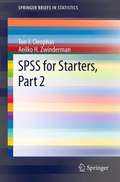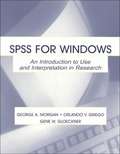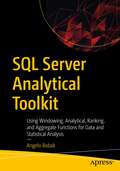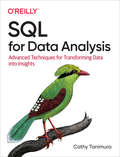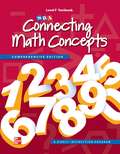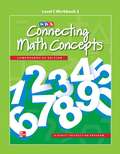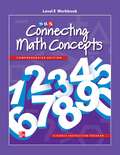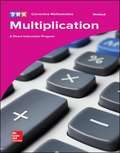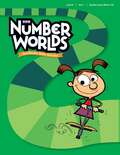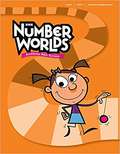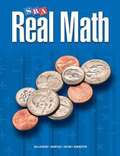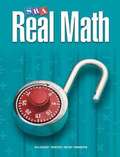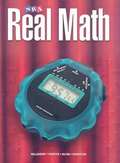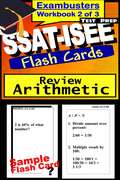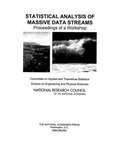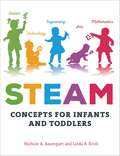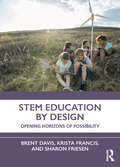- Table View
- List View
SPSS for Starters, Part 2
by Aeilko H. Zwinderman Ton J. CleophasThe first part of this title contained all statistical tests that are relevant for starters on SPSS, and included standard parametric and non-parametric tests for continuous and binary variables, regression methods, trend tests, and reliability and validity assessments of diagnostic tests. The current part 2 of this title reviews multistep methods, multivariate models, assessments of missing data, performance of diagnostic tests, meta-regression, Poisson regression, confounding and interaction, and survival analyses using log tests and segmented time-dependent Cox regression. Methods for assessing non linear models, data seasonality, distribution free methods, including Monte Carlo methods and artificial intelligence, and robust tests are also covered. Each method of testing is explained using a data example from clinical practice,including every step in SPSS, and a text with interpretations of the results and hints convenient for data reporting. In order to facilitate the use of this cookbook the data files of the examples is made available by the editor through extras.springer.com. Both part 1 and 2 of this title contain a minima amount of text and maximal technical details, but we believe that this property will not refrain students from mastering the SPSS software systematics, and that, instead, it will be a help to that aim. Yet, we recommend that it will used together with the textbook "Statistics Applied to Clinical Trials" (5th edition, Springer, Dordrecht 2012) and the e-books "Statistics on a Pocket Calculator Part 1 and 2 (Springer, Dordrecht, 2011 and 2012) from the same authors.
SPSS for Starters, Part 2 (SpringerBriefs in Statistics)
by Aeilko H. Zwinderman Ton J. CleophasThe first part of this title contained all statistical tests that are relevant for starters on SPSS, and included standard parametric and non-parametric tests for continuous and binary variables, regression methods, trend tests, and reliability and validity assessments of diagnostic tests. The current part 2 of this title reviews multistep methods, multivariate models, assessments of missing data, performance of diagnostic tests, meta-regression, Poisson regression, confounding and interaction, and survival analyses using log tests and segmented time-dependent Cox regression. Methods for assessing non linear models, data seasonality, distribution free methods, including Monte Carlo methods and artificial intelligence, and robust tests are also covered. Each method of testing is explained using a data example from clinical practice,including every step in SPSS, and a text with interpretations of the results and hints convenient for data reporting. In order to facilitate the use of this cookbook the data files of the examples is made available by the editor through extras.springer.com. Both part 1 and 2 of this title contain a minima amount of text and maximal technical details, but we believe that this property will not refrain students from mastering the SPSS software systematics, and that, instead, it will be a help to that aim. Yet, we recommend that it will used together with the textbook "Statistics Applied to Clinical Trials" (5th edition, Springer, Dordrecht 2012) and the e-books "Statistics on a Pocket Calculator Part 1 and 2 (Springer, Dordrecht, 2011 and 2012) from the same authors.
SPSS for Windows: An Introduction to Use and Interpretation in Research
by George A. Morgan Orlando V. Griego Gene GloecknerA supplementary textbook for a graduate or undergraduate introductory course in research methods or statistics in the behavioral sciences or education. Morgan (education and human development, Colorado State U.), Orlando V. Griego (business and management, Azusa Pacific U.), and Gene W. Gloeckner (education, Colorado State U.) help students learn how to analyze and interpret research data using the Statistical Products and Service Solutions statistical software package in a Microsoft Windows environment. No background in statistics is assumed. The disk contains data files for the laboratory exercises. Annotation c. Book News, Inc., Portland, OR (booknews.com)
SPSS/PC+ Made Simple
by John HeddersonAfter twelve years of teaching SPSS, SPSSx, and SPSS/PC+, I am convinced that SPSS/PC+ is not easy for the average college student to learn. I am also convinced that it is not easy to teach from the program manuals. Students who are experienced with statistics and programming or students with a high aptitude for this type of work will learn SPSS/PC+ easily. The rest suffer. Typically, my students have scant training in statistics or programming. Often they are not comfortable with mathematics, computers, and "that sort of thing." I wrote SPSS/PC+ Made Simple to help these students and their instructors
SQL Server Analytical Toolkit: Using Windowing, Analytical, Ranking, and Aggregate Functions for Data and Statistical Analysis
by Angelo BobakLearn window function foundational concepts through a cookbook-style approach, beginning with an introduction to the OVER() clause, its various configurations in terms of how partitions and window frames are created, and how data is sorted in the partition so that the window function can operate on the partition data sets. You will build a toolkit based not only on the window functions but also on the performance tuning tools, use of Microsoft Excel to graph results, and future tools you can learn such as PowerBI, SSIS, and SSAS to enhance your data architecture skills.This book goes beyond just showing how each function works. It presents four unique use-case scenarios (sales, financial, engineering, and inventory control) related to statistical analysis, data analysis, and BI. Each section is covered in three chapters, one chapter for each of the window aggregate, ranking, and analytical function categories.Each chapter includes several TSQL code examples and is re-enforced with graphic output plus Microsoft Excel graphs created from the query output. SQL Server estimated query plans are generated and described so you can see how SQL Server processes the query. These together with IO, TIME, and PROFILE statistics are used to performance tune the query. You will know how to use indexes and when not to use indexes.You will learn how to use techniques such as creating report tables, memory enhanced tables, and creating clustered indexes to enhance performance. And you will wrap up your learning with suggested steps related to business intelligence and its relevance to other Microsoft Tools such as Power BI and Analysis Services.All code examples, including code to create and load each of the databases, are available online.What You Will LearnUse SQL Server window functions in the context of statistical and data analysisRe-purpose code so it can be modified for your unique applicationsStudy use-case scenarios that span four critical industriesGet started with statistical data analysis and data mining using TSQL queries to dive deep into dataStudy discussions on statistics, how to use SSMS, SSAS, performance tuning, and TSQL queries using the OVER() clause.Follow prescriptive guidance on good coding standards to improve code legibility Who This Book Is ForIntermediate to advanced SQL Server developers and data architects. Technical and savvy business analysts who need to apply sophisticated data analysis for their business users and clients will also benefit. This book offers critical tools and analysis techniques they can apply to their daily job in the disciplines of data mining, data engineering, and business intelligence.
SQL for Data Analysis: Advanced Techniques for Transforming Data into Insights
by Cathy TanimuraWith the explosion of data, computing power, and cloud data warehouses, SQL has become an even more indispensable tool for the savvy analyst or data scientist. This practical book reveals new and hidden ways to improve your SQL skills, solve problems, and make the most of SQL as part of your workflow.You'll learn how to use both common and exotic SQL functions such as joins, window functions, subqueries, and regular expressions in new, innovative ways--as well as how to combine SQL techniques to accomplish your goals faster, with understandable code. If you work with SQL databases, this is a must-have reference.Learn the key steps for preparing your data for analysisPerform time series analysis using SQL's date and time manipulationsUse cohort analysis to investigate how groups change over timeUse SQL's powerful functions and operators for text analysisDetect outliers in your data and replace them with alternate valuesEstablish causality using experiment analysis, also known as A/B testing
SRA Connecting Math Concepts, Comprehensive Edition, Student Assessment Book, Level D (Connecting Math Concepts)
by Sra McGraw-HillNIMAC-sourced textbook
SRA Connecting Math Concepts, Comprehensive Edition, Workbook 2, Level C
by Douglas Carnine Siegfried Engelmann Bernadette KellySRA Connecting Maths Concepts Comprehensive Edition has been revised for Levels A-F and students in Grades K-5. This program gives students who are at-risk of falling behind or who have already significantly fallen behind the chance to catch up and learn significant mathematics. New digital resources accompany the program including Practice Software, Board Displays and eBook Teacher Guides and Presentation Books.
SRA Connecting Math Concepts, Comprehensive Edition, Workbook, Level E
by Siegfried Engelmann Bernadette Kelly Owen EngelmannSRA Connecting Maths Concepts Comprehensive Edition has been revised for Levels A-F and students in Grades K-5. This program gives students who are at-risk of falling behind or who have already significantly fallen behind the chance to catch up and learn significant mathematics. New digital resources accompany the program including Practice Software, Board Displays and eBook Teacher Guides and Presentation Books.
SRA Corrective Mathematics Workbook: Multiplication (Corrective Math Series)
by Raymond Chang McGraw-Hill Education Editors McGraw-Hill EditorsWorkbooks include daily worksheets and point summary charts for recording student performance and awarding grades.
SRA Number Worlds™ Accelerate Math Success, Level D, Unit 1: Number Sense Within 100, Student Workbook (Number Worlds Series)
by Sharon Griffin Douglas H. Clements Julie SaramaNIMAC-sourced textbook
SRA Number Worlds™: Accelerate Math Success, Level E, Unit 5: Geometry & Measurement, Student Workbook (Number Worlds Ser.)
by Sharon Griffin Julie Sarama Douglas ClementsNIMAC-sourced textbook
SRA: Real Math, Grade 2
by Carl Bereiter Stephen S. Willoughby Peter HiltonSecond grade consumable math workbook
SSAT-ISEE Test Prep Flash Cards: Arithmetic (Exambusters SAT-ISEE Workbook #2 of 3)
by Ace Inc.<P><P><i>Advisory: Bookshare has learned that this book offers only partial accessibility. We have kept it in the collection because it is useful for some of our members. Benetech is actively working on projects to improve accessibility issues such as these.</i><P><P> "SSAT-ISEE Prep Flashcard Workbook 2: ARITHMETIC REVIEW" 600 questions and answers highlight essential arithmetic definitions, problems, and concepts. Topics: Addition, Subtraction, Multiplication, and Division of Whole Numbers; Fractions and Decimals, Multiplication Tables, Word Problems, Percents, Measurement, Metric System, Square Roots and Powers, Real Numbers, Properties of Numbers <P>EXAMBUSTERS SSAT and ISEE Prep Workbooks provide comprehensive, fundamental SSAT and ISEE review--one fact at a time--to prepare students to take practice SSAT and ISEE tests. Each SSAT and ISEE study guide focuses on one specific subject area covered on the SSAT and ISEE exams. From 300 to 600 questions and answers, each volume in the SSAT and ISEE series is a quick and easy, focused read. Reviewing SSAT and ISEE flash cards is the first step toward more confident SSAT and ISEE preparation and ultimately, higher SSAT and ISEE exam scores!
STAAR CONNECTION Diagnostic Series: Math Grade 5
by The Editors at the KAMICO Instructional MediaGrade 5 Math Test Prep
STATISTICAL ANALYSIS OF MASSIVE DATA STREAMS: Proceedings of a Workshop
by Committee on Applied Theoretical StatisticsMassive data streams—large quantities of data that arrive continuously—are becoming increasingly commonplace in many areas of science and technology. Consequently development of analytical methods for such streams is of growing importance. To address this issue, the National Security Agency asked the NRC to hold a workshop to explore methods for analysis of streams of data so as to stimulate progress in the field. This report presents the results of that workshop. It provides presentations that focused on five different research areas where massive data streams are present: atmospheric and meteorological data; high-energy physics; integrated data systems; network traffic; and mining commercial data streams. The goals of the report are to improve communication among researchers in the field and to increase relevant statistical science activity.
STEAM Concepts for Infants and Toddlers
by Linda R. Kroll Nichole A. BaumgartThis book is about using Science, Technology, Engineering, the Arts, and Mathematics with very young children. STEAM is an extension of the original STEM efforts to develop scientific and mathematical thinking for use in technology and engineering with the addition of the arts and the goal to support the native creativity and innovation that all children possess. This book is organized into three sections. The first section introduces the book and discusses infant and toddler learning and development in relationship to STEAM concepts. The second section (chapters 2-6) is a series of examples of STEAM curricula in infant and toddler classrooms. The final section (chapters 7-9) focuses on classroom environments and setting up a context for effective development of STEAM curricula for teachers and effective STEAM concept learning for infants and toddlers.
STEAM Teaching and Learning Through the Arts and Design: A Practical Guide for PK–12 Educators
by Debrah C. Sickler-VoigtIn this book, award-winning art educator Debrah C. Sickler-Voigt offers user-friendly, approachable strategies for STEAM planning, instruction, and assessment to help cultivate PK-12 students’ full potential, and draws from wide-ranging artists and designers to help you develop inspired, creative approaches to teaching STEAM in your classroom. Beginning with the basics and best practices of STEAM planning, instruction, and assessment, Sickler-Voigt then encourages readers to move full steam ahead with chapters based around diverse contemporary and historical artists and designers. In helping you to explore the interdisciplinary connections between Science, Technology, Engineering, Arts, and Mathematics, Sickler-Voigt identifies strategies to build off from STEM subjects to form authentic, well-designed, and age-appropriate learning tasks that encourage your students to make deep connections and learn subject matter in context through art media and technologies. Each chapter includes flexible, choice-based classroom resources—with tips for adapting to different grade levels—and STEAM amplifiers, which fuse contextual learning on artists and designers with real-world STEAM topics to spark student learning and ignite creative approaches to planning, instruction, and assessment. Featuring 150 visually stunning, full-color images, this book fuses tried-and-true best practices with highly applicable instructional models inspired by artists and STEAM professionals, ideal for PK-12 teachers and STEAM specialists.
STEM Education Across the Learning Continuum: Early Childhood to Senior Secondary
by Steve Murphy Amy MacDonald Lena DanaiaThis is the first comprehensive book to consider STEM education from early childhood through to senior secondary education. It approaches STEM as a form of real-world, problem-based education that draws on the knowledge and skills of the science, technology, engineering and mathematics disciplines. Rather than presenting each of the separate disciplines to an equal extent, it focuses on STEM researchers’ perspectives on how their work contributes to effective STEM education in terms of building knowledge, skills and engagement. Gathering contributions by authors from various countries, the book explores effective STEM education from a range of perspectives within the international context. Moreover, it addresses critical issues in STEM education, including transition and trajectories, gender, rurality, socioeconomic status and cultural diversity. By doing so, it not only shares the current state of knowledge in this field, but also offers a source of inspiration for future research.
STEM Education by Design: Opening Horizons of Possibility
by Sharon Friesen Brent Davis Krista FrancisAn accessible text that assumes no prior knowledge, this book is grounded in the realization that "STEM" and "STEM Education" have not yet evolved into fully coherent fields of study, and fills this gap by offering an original model and strategy for developing coherences in a way that both honors the integrity of each of STEM’s constituent disciplines and explores the ways they can amplify one another when used together to address complex contemporary issues. This book demonstrates how STEM can and should be understood as more than a collection of disciplines; it is a transdisciplinary, possibility-rich domain that is much more than the sum of its parts. Building on the actual work of scientists, engineers, and other professionals, the authors disrupt preconceptions about STEM domains, and provide the tools and evidence-based approaches to create new possibilities for all learners. Covering historical influences, theoretical frameworks, and current debates and challenges, this book positions teachers and students as agents of change. Each chapter features In Brief openers to introduce the topic; Opening Anecdotes to reflect the chapter’s key themes; Sidebars to put core principles in context; Consolidating Key Points activities to summarize and highlight important details; and Challenges to build upon and extend topics explored in the chapter from different angles.
